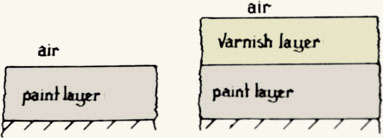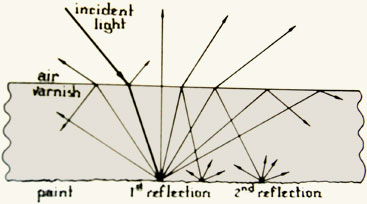Optical Properties of the Paint Surface
Paintings using egg tempera and those using oil demonstrate different optical properties. With egg tempera, the dried egg is uneven, making the paint surface matte. With oil paintings, the dried oil surface is smooth and so the paint surface is smooth. What happens to light striking these two surfaces?
For the uneven egg tempera, the light is scattered in all directions and is not directed into the observer’s eye. For the smooth oil, the light is scattered in one direction and is directed into the observer’s eye. Therefore, oil paintings gain an added brilliance from the light scattered directly into the observer’s eye.
The role of varnish
Varnish is a solution of a colorless resin (dammar) in a colorless solvent (turpentine). For the most part, egg-tempera paintings appear not to have been varnished. In contrast, most oil paintings were varnished and the varnish gives them added brilliance.

Egg tempera (left)
Oil (right)
The varnish layer on oil paintings gives them added brilliance.
The varnish layer is applied on top of the paint layer. The varnish surface, like the oil paint surface, is smooth. Oil paint surfaces, with or without varnish, show added brilliance because light is reflected from smooth surfaces.
The function of varnish is primarily protective, but is also decorative. Over time, however, either a yellowing or darkening of the varnish film can take place. Because paintings did not always hang in the ideal surroundings of a museum or gallery, the environment in which paintings hung – such as exposure from coal fire smoke in people’s homes – could play havoc with them.
Considering all that you have read, what would you have to bear in mind when looking at what are referred to as “Old Masters” , however talented the painter. Look for example at some early Titians.

The varnish layer returns the light to the paint layer for a second interaction with the pigment before it enters the observer’s eye.
The varnish layer has another effect, in that it greatly accentuates color and depth. In the absence of varnish, light strikes the surface, enters the paint layer, interacts with the pigment particles and is reflected out into the observer’s eye. Imagine it as a direct, in-and-out process.
As illustrated in the above diagram, the varnish layer interrupts this process, returning the light to the paint layer for a second interaction with the pigment before it enters the observer’s eye. Multiple reflections of this sort intensify the color of the pigment and contribute to the brilliance of oil paintings.